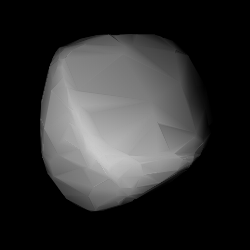Top Qs
Timeline
Chat
Perspective
3430 Bradfield
Agnia asteroid From Wikipedia, the free encyclopedia
Remove ads
3430 Bradfield (prov. designation: 1980 TF4) is a stony Agnia asteroid from the central regions of the asteroid belt, approximately 8 kilometers (5 miles) in diameter. It was discovered on 9 October 1980, by American astronomer Carolyn Shoemaker at the Palomar Observatory in California. The Sq-type asteroid was named after comet hunter William A. Bradfield.[1]
Remove ads
Orbit and classification
When applying the hierarchical clustering method to its proper orbital elements according to Nesvorný, Bradfield is a member of the Agnia family (514),[3] a very large family of stony asteroids with more than 2000 known members.[5] They most likely formed from the breakup of a basalt object, which in turn was spawned from a larger parent body that underwent igneous differentiation.[6] The family's parent body and namesake is the asteroid 847 Agnia.[5] In the 1995-HCM analysis by Zappalà, however, it is a member of the Liberatrix family (also described as Nemesis family by Nesvorný).[3][7]
It orbits the Sun in the central main-belt at a distance of 2.5–3.0 AU once every 4 years and 7 months (1,674 days; semi-major axis of 2.76 AU). Its orbit has an eccentricity of 0.10 and an inclination of 4° with respect to the ecliptic.[2] The body's observation arc begins with its observations as 1974 HY1 at Cerro El Roble Observatory in April 1974, more than 6 years prior to its official discovery observation at Palomar.[1]
Remove ads
Naming
This minor planet was named after New Zealand-born Australian amateur astronomer and rocket engineer William A. Bradfield (1927–2014). A discoverer of several comets himself, he significantly increased the rate of discovery of bright comets from the southern hemisphere during the 1970s and 1980s.[1] The official naming citation was published by the Minor Planet Center on 14 April 1987 (M.P.C. 11750).[8]
Remove ads
Physical characteristics
In the SMASS classification, Bradfield is an Sq-subtype, that transitions between the common, stony S-type and Q-type asteroids.[2]
Diameter and albedo
According to the survey carried out by the NEOWISE mission of NASA's Wide-field Infrared Survey Explorer, Bradfield measures 8.492 kilometers in diameter and its surface has an albedo of 0.269.[4]
Rotation period
As of 2018, no rotational lightcurve of Bradfield has been obtained from photometric observations. The body's rotation period, pole and shape remain unknown.[2]
References
External links
Wikiwand - on
Seamless Wikipedia browsing. On steroids.
Remove ads

